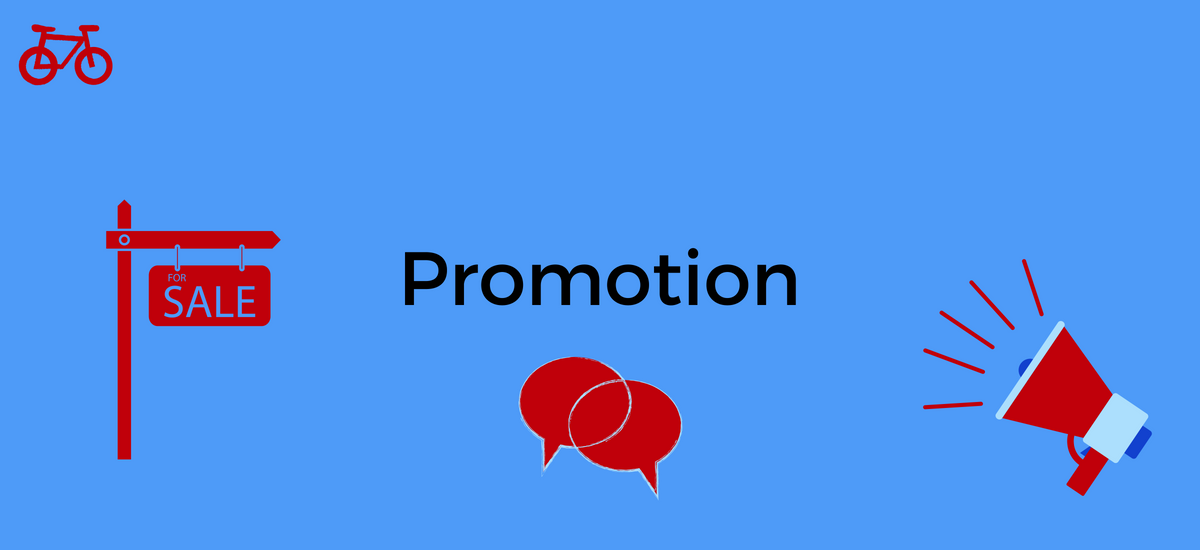Making the world and your customers aware of your product is essential to success. That’s why the marketing mix addresses promotion.
Promotion, as a component of the marketing mix, deals with how you communicate with the world. This includes your customers and prospective customers.
Here, we are going to have an overview of all of the components of promotion.
What is Promotion?
Promotion, as it relates to the marketing mix, is all the communication activities a company performs to inform its customers and prospective customers about its company and products.
Promotion is how companies establish their brand, the company voice, communicate features and benefits, build awareness, and persuade customers and prospective customers.
Since promotion is everything to do with communication, it is often referred to as marketing communication. Thus, the mix of activities may also be referenced as the marketing communications mix.
Promotion is an essential component of the marketing mix and it contains its own set of components, which we will discuss in detail below.
The Role of Promotion
The role of promotion is communication. This is how a company will communicate to their customers and prospective customers.
A company will do this through various activities, which are detailed in the promotional mix. A company can use one or all of the promotional mix activities to effectively communicate with their customers and prospective customers.
What is the Promotional Mix?
The promotional mix is the set of activities that a company uses to communicate with customers and attract prospective customers. It refers to all the activities that a company will employ, as it relates to communication, to reach the company’s goals.
Below are all the elements in the promotional mix.
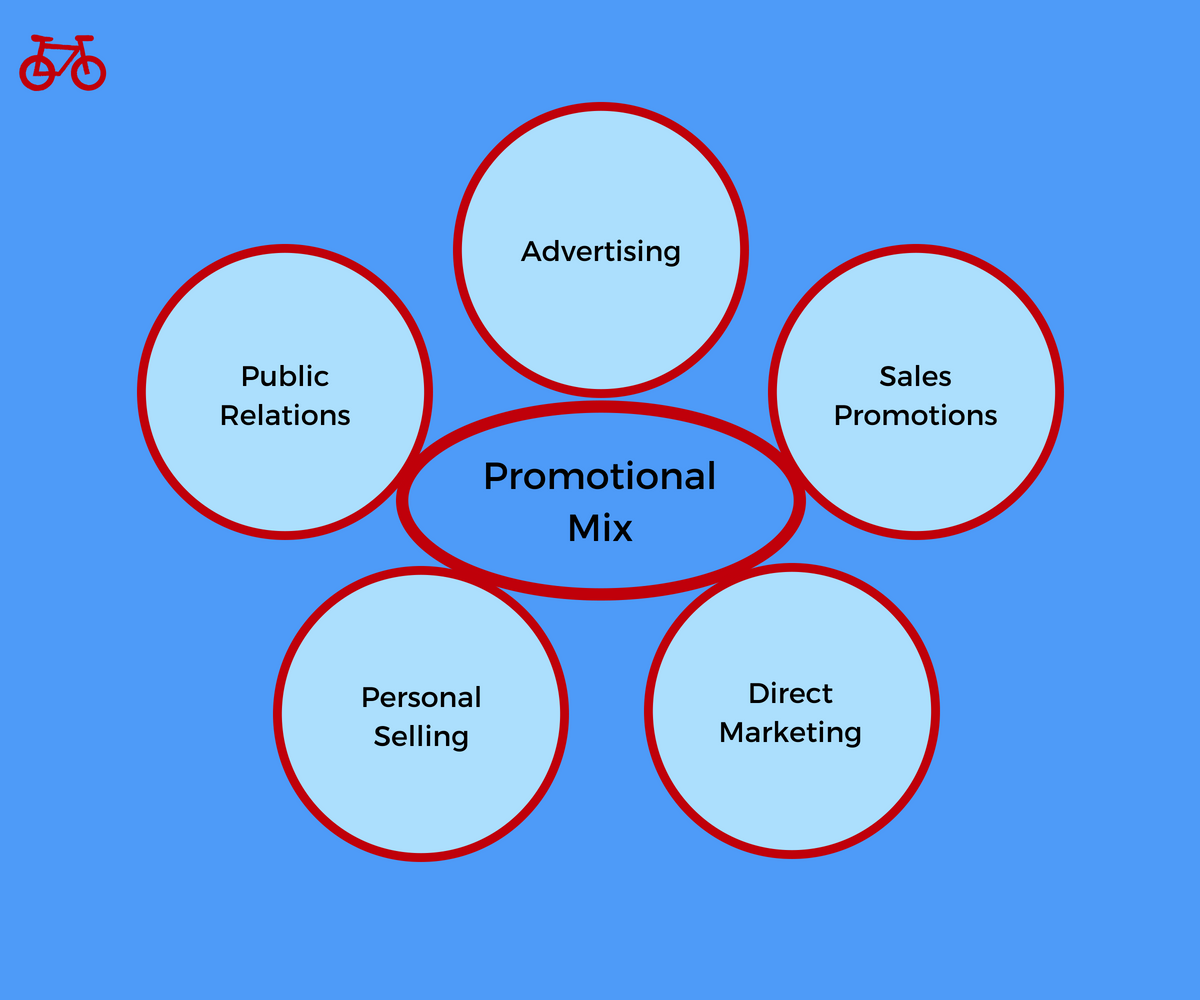
Advertising
Advertising is the messages that are paid for by a company to promote a product or service. Advertising is a non-personal message that is usually audio or visual.
This is a critical component of the promotional mix, as companies can control the message of their brand or service to large targeted audiences.
The advertising component of the promotional mix includes both traditional advertising mediums, such as print and television, as well as digital advertising mediums.
Sales Promotions
Sales promotions are short-term marketing communications that drive customers and prospective customers to act. Sales promotions use media and non-media channels to communicate an offer that is aimed at increasing demand.
Sales promotions can include coupons, rebates, discounts, inventory clearing sales, or product samples.
The goal of sales promotions is to provide an incentive to get customers and prospective customers to act in given time period.
Public Relations
Public relations (PR) is the promotional mix component that includes PR, publicity, and sponsorship.
Public relations are activities and campaigns that are used to influence target audiences. This can be used to influence an audience’s perception for branding purposes. But, it can also be used to influence an audience to cause them to act.
PR can be seen in the form of interviews, speaking engagements, sponsorships, or events. It is a difficult component to get right. And, the lines between advertising and public relations continues to get blurred.
Personal Selling
Personal selling is the component of the promotional mix that uses sales representatives to sell products and services to individual clients. In a business environment, we would simply call this “sales”.
In personal selling, a sales representative will engage prospective customers through prospecting. Then, the sales representative will use the sales process to nurture the prospect. This is done through conveying the features and benefits of a product. This is all done in order to turn the prospect into a customer.
Personal selling is done on a personal level, from a sales representative to a prospective customer.
Direct Marketing
Direct marketing is the component of the promotional mix that uses tools and tactics to market directly to end users. The end users are the customers or prospective customers who will directly use the product or service.
Direct marketing contains activities such as mailing campaigns, emailing campaigns, telemarketing, mail order, text messages, social media, websites, and various forms of online content and advertising.
It encompasses all the marketing activities you do directly to end users.
Understanding the components of the promotional mix and how you choose to apply them is essential to your business. You can choose to use one or many of the components. By choosing, you can then build the promotional mix that best fits your business.
What are the Objectives of Promotion?
There can be many objectives to promotion. It is not always just to drive an immediate sale, or an immediate customer reaction.
You can have activities where you would like to change perceptions, just make people aware, or create an immediate sale. Below, we discuss a number of promotional objectives.

Awareness
Promotion is about the outward portrayal of your company. Thus, gaining awareness for your company within your target market is crucial. Promotion seeks to make prospective customers aware that your company or product exists.
As an objective, this can be measured in many ways. A classic measurement is through brand recognition measurements. More recent measurements can include website traffic, social media engagement, email subscribers, and company followers. Although, with each of these metrics there is hot debate as to the weight one should give to them.
The first step in promotion, and in your company, is to make your target market aware you exist.
Demand Generation
Demand generation is the promotional activity that takes prospective customers from being aware of your product to having interest in purchasing.
For consumer products, this can be making a visit to a retail store or actively shopping online. For business to business products, this can be requesting free trials or speaking with a sales representative.
The demand generation process is about nurturing those in your target market that have become aware of you. Then, using various messaging, promotions, and campaigns to cause them to act.
Communication
The promotional mix is not only an opportunity to communicate with prospective customers, but is also about communicating with existing customers.
Customer communication can come in the form of offering promotions for existing customers to purchase new product releases. Or, to purchase more of their existing products. The communication objective can also be simply about making customers aware of product features and providing additional value.
Retaining customers is an important part of the marketing function. Communication is the foundation for this objective.
Branding
Branding, although one of the most difficult measures in marketing, is an objective of promotion. Brand is all about how customers and prospective customers view your company. This is accomplished through giving your company a personality. It is about storytelling.
So, if promotion is about communication, branding is how customers and prospective customers perceive your communication.
Differentiation
An objective of promotion is to use available communication tools to differentiate your products from your competitors. This is accomplished through communicating product features and benefits.
Features and benefits can be described through various communication channels. Traditionally, companies have used advertising and media to differentiate. It has been done through active comparisons in commercials or case studies. Or, it can simply be making features and benefits explicitly clear through awareness communication and demand generation.
However, differentiating your product from the competition is a promotional objective.
Sales
Increasing sales and generating new sales is the ultimate objective of promotion.
This can happen through gaining more awareness and turning more of those aware prospective customers into customers. Meaning, you can grow your funnel of interested customers through better branding, better communication, or better awareness and demand generation. This is a more long-term view of generating sales.
The other way to accomplish this objective, is to use short-term sales promotions. These have a direct impact on sales. The results happen almost immediately.
Generating sales should be the ultimate measurement of all the promotional campaigns that you run.
Who is the Promotional Audience?
Promotion and its objectives are great, but who should ultimately receive your promotional communication?
It isn’t just one group. We don’t want our promotion activities to just be for prospective customers or existing customers. There are other groups that can assist us in reaching our objective.
Below are some of the audiences we should target with our promotional activities.
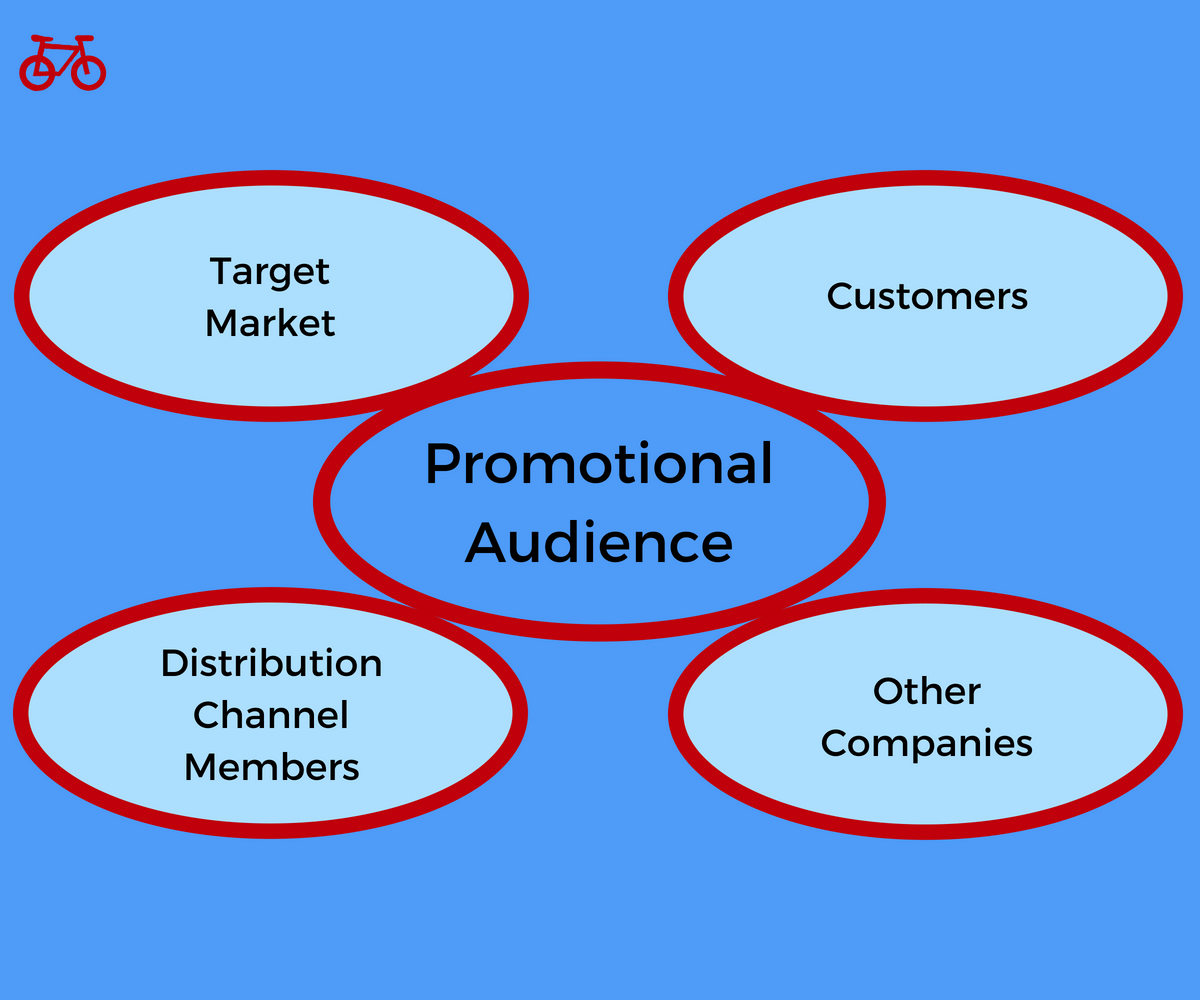
Target Market
First and foremost, our target market should receive our communication. This is going to be our target prospective customers. They should receive our messaging and promotions.
This can be our awareness, demand generation, or sales promotion communication. A focal point of our promotional efforts should be on our target market.
Customers
Existing customers should receive promotional activities. This can be customer communication, branding efforts directed at customers, and sales promotions focused on increasing existing customer value.
Promotion should be focused at customers, because they are already receptive to communication. Also, they are likely to already like your product. Thus, it is far more effective to direct massaging at an audience that is already open to hearing from you.
Distribution Channel Members
Focusing marketing communication on your distribution channel has many advantages. Depending on the structure of your distribution chain, providing incentive for your channel partners to push your product can result in a sales increase.
Communication with your channel can be through promotions to channel partners, increased awareness activities directed to a retailer, or communicating product differentiation.
This is an important audience that can benefit from focused promotional activity.
Other Companies
Promotion can be targeted at a general audience of other companies for the purposes of partnerships. Typically, these partnerships will be in the form of co-marketing activities.
This type of promotional audience is good for sharing target audiences or customers. Effectively expanding the audience that is aware of your products.
The audiences that you choose to focus promotional activities on are important. It is good to remember there are many audiences you can address.
Promotional Mix Considerations
When building your promotional mix, there are many factors to consider. These considerations will help drive messaging, sales promotions, and audience targeting.
Below are some considerations in building your promotional mix.

The Product
The first thing to consider is your product. Things to consider regarding the product are:
- The type of product
- How the product is consumed
- Where the product is consumed
- How the product is found
These factors surrounding your product will enable you to build a promotional mix that matches your product.
Product Lifecycle Stage
The product lifecycle stage is important. This can determine whether you need offensive or defensive marketing strategies. This can affect how you communicate about your competitors.
If you have a product that is in the growth stage, there will be more promotional attention paid to awareness. Whereas, a product in maturity might have more promotional activity focused on sales promotions and channel partner communication.
Based on the products lifecycle, strategies can be implemented that compliment how the product is positioned in the market.
Budget
The allocated budget to promotion is obviously a huge factor. This will determine how much promotion, what types of promotion, and the promotional channels to be used.
Also, budget can have an impact on the return on investment (ROI) of your promotional campaigns. Reason being that too little budget will not afford you economies of scale. While too much budget may actually saturate your audience. This can cause the law of diminishing returns.
While budget will dictate what promotional activities you can do, optimizing your budget based on your promotional mix is also important.
Audience
The audience consideration is one that dictates many of the factors around your messaging and where to place your messaging.
The important factor here is to know who your audience is and understand a little bit about them. Understanding is about their personalities. These factors will allow you to tailor your promotional strategies to fit the audience.
Understanding your audience is an essential part to building an effective promotional mix.
Competition
Competition might dictate many of your promotional mix strategies. Keeping an eye on the competition is about keeping your messaging such that you can differentiate your products.
Also, it is being able to be responsive to sales promotion activities, as well as being proactive with promotional activities.
Keeping up with the competition is an important consideration in your promotional mix.
These are some of the critical considerations you should make when thinking about your promotional mix. While this is not an exhaustive list, it will get you started with building an effective mix of activities.
What are Promotional Strategies?
Promotional strategies are the strategies you will use to execute your promotional mix. This is the mix of tactics that allow you to influence your target market.
There are two main promotional strategies. There is the push promotion strategy and the pull promotion strategy. These are different from promotional tactics. Promotion tactics are things like contests, giveaways, social media, and events.
The following is an overview of push and pull promotional strategies.
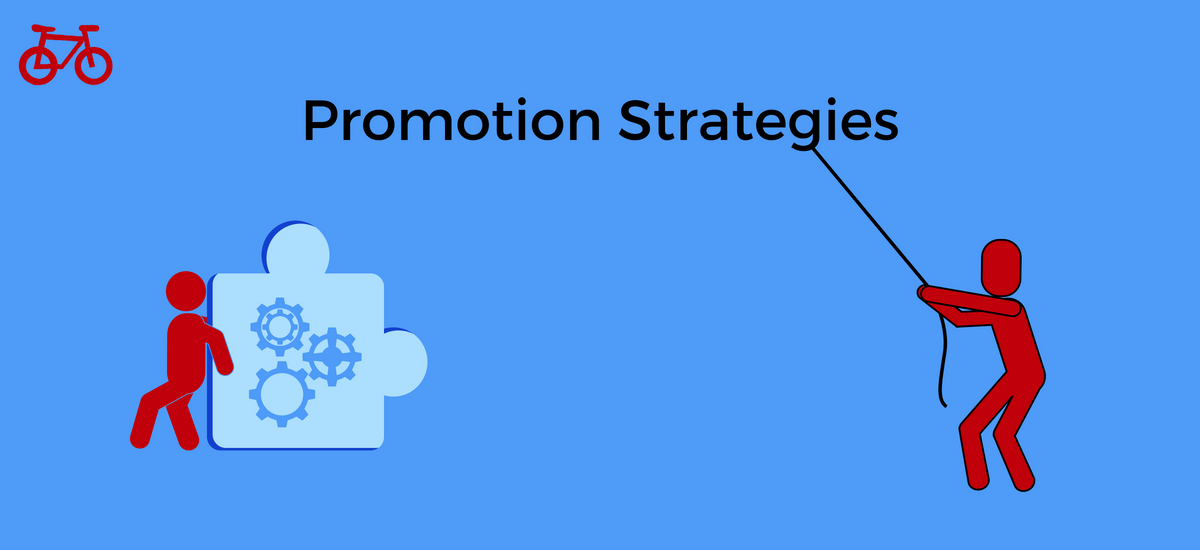
Push Promotion Strategy
Push promotion is the aggressive promotional strategy that businesses use to get their product or message in front of an audience. This is used regardless of whether the audience would like to hear about your product or not.
Ultimately, the strategy is exactly how the name sounds. Pushing your product or service onto your target audience.
This tends to be considered an interruption strategy. Where the business is interrupting their prospective customers to get them to become aware of their product or service. This is an effective strategy when your brand or product is unknown. It generates quick results and can be relatively cost effective.
Examples of this form of promotion are television ads. Your show is interrupted to hear from companies you may or may not be interested in. Also, you probably did not request to hear from them.
Pull Promotion Strategy
Pull promotion is a demand generation strategy. This is when a business uses tactics to pull people into their product or service. This is a demand generation strategy.
Pull promotion can be seen in concepts like permission marketing, lead nurturing, or inbound marketing. The goal is not to interrupt your audience. Rather, it is about creating interest for the product and to be there when the prospective audience is looking for you.
An example of pull promotion is when a video goes viral online.
These are the two basic strategies of promotion. Essentially every promotion tactic can be classified as one of these two strategies.
Types of Promotion
There are various types and mediums of promotion. The different mediums of promotion all fall into three basic categories. There is physical promotion, traditional media, and digital media.
Within these three categories, you can place all available mediums of promotion. Which, the mediums of promotion are changing as we get more digital mediums. Find better ways to use physical mediums and as the laws or traditional media change.
Thus, we can look at the three types of promotion below.
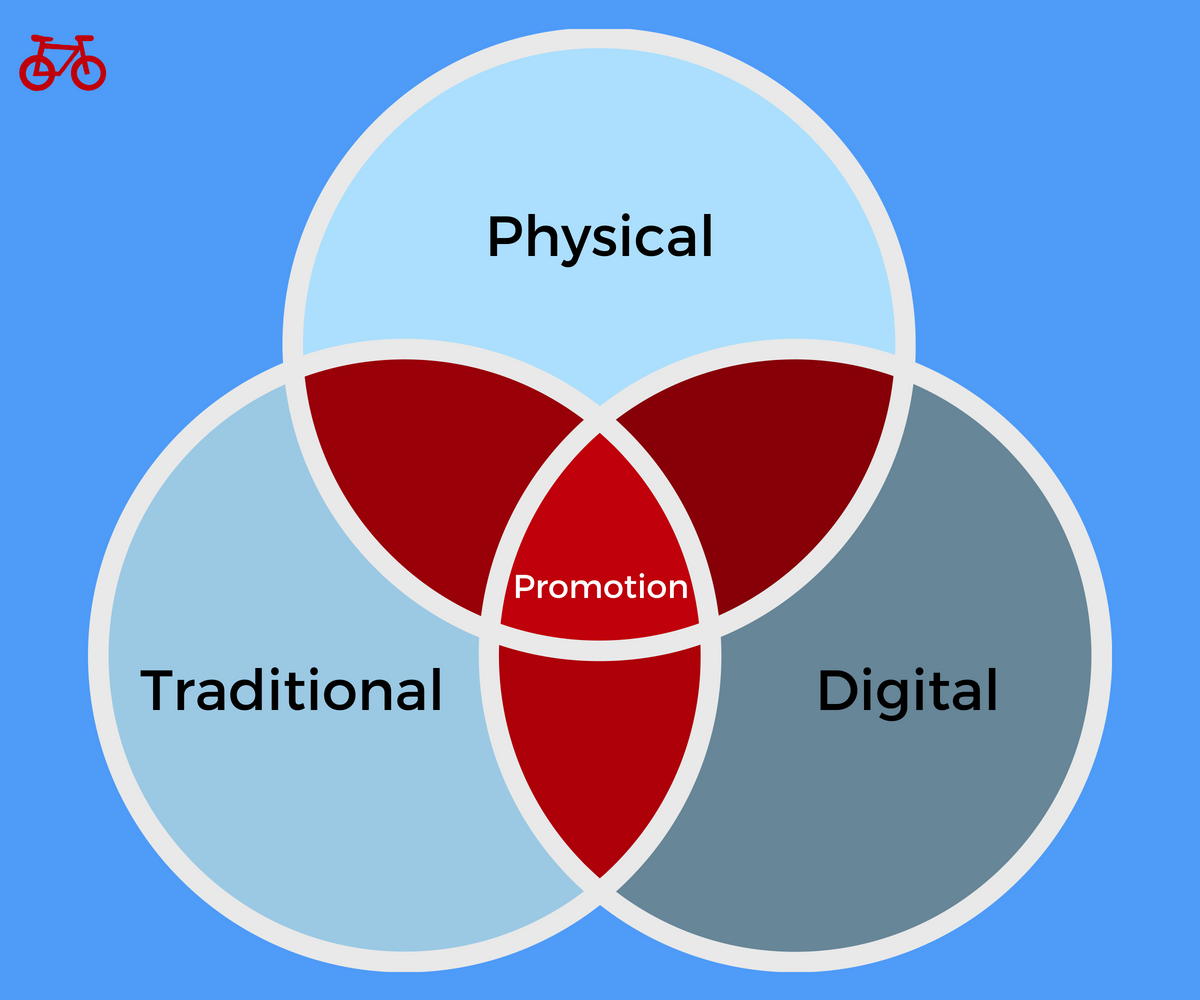
Physical Promotion
Physical promotion are the promotional mediums and activities that occur in a physical environment. The mediums and tactics that occur in a physical environment are things like trade shows, events, meetups, festivals, and brand ambassadors.
These mediums do change and evolve, as well as their effectiveness. They work, and given the correct execution, can be an effective piece to your promotional mix.
Traditional Media Promotion
Traditional media are the mediums of promotions that we all think of. Things like newspapers, billboards, television, and radio. Although the nature of these mediums is changing, they can still be an effective piece of your promotional mix.
Digital Media Promotion
Digital media promotion is the all-encompassing type of promotion that refers to everything digital. That is all of our mediums on the internet, computers, and mobile devices.
This is the newest and most disruptive medium of promotion. It is rapidly changing and it is cost effective. There is a lot of evidence to suggest that the digital media mediums are essential to any promotional mix.
Digital media promotion includes mediums such as your website, social media, and pay-per-click advertising.
Promotion is the communication component of the marketing mix. This is how you make the world aware you exist, how you communicate with your customers, and how you shape the perception around your product and service. Promotion is a key component of the marketing mix and one that can directly impact growth and sales.
